Giant’s Causeway, Northern Ireland
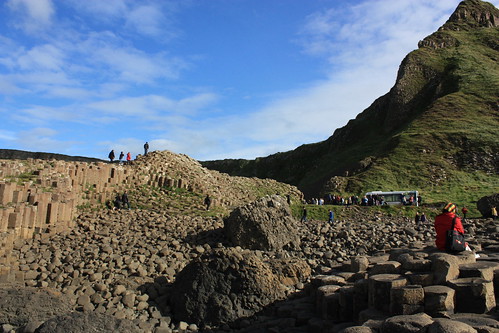
Fortunately, even non-giants are allowed to explore the area.
–
While we were in Northern Ireland, I decided that we needed to visit the Giant’s Causeway despite not really knowing what it was. When Rand asked, I replied with the rather vague and not-entirely accurate, “It’s a big rocky thingy. Um … with giants.”
My explanation, he pointed out, was in no way helpful. Fortunately, upon stopping by the newly-built visitor’s center, we came back with a slightly clearer picture.

From this angle it looks a wee bit like a bomb shelter, but it’s really quite nice inside.
–
The Giant’s Causeway is the result of ancient volcanic activity. About 50 to 60 million years ago, a volcanic eruption caused molten basalt (which is regular salt, I guess, but, you know … has a “ba” in front of it) to seep through chalk beds, creating a wide, flat surface which then cooled rapidly. This caused the basalt to contract and form tall hexagonal columns.

–
The cooling caused further striations, so that the columns look like they are composed of many small “biscuits” (I didn’t come up with that. Apparently other people see cookies everywhere, too). The biscuits have convex tops and concave bottoms, so they fit together neatly, like a very elaborate game of Jenga.

Some of the basalt “biscuits”. Water pools in the concave impressions.
–
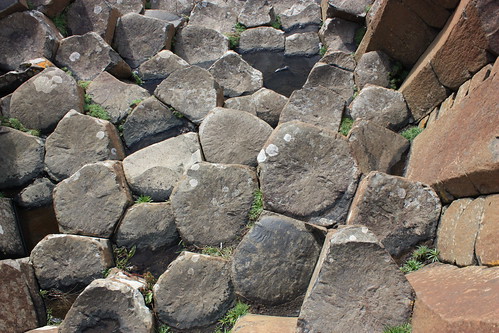
Like snacks from the worst tea party, ever.
–

–
To recap: ancient volcano makes cool rocks.
There’s another story, too, about how the Causeway came to be. It involves an Irish warrior named Finn MacCool (Yes, I know. “Finn MacCool” sounds like a spokesman for a light beer circa 1984, but I swear, that’s what he was called), who built a causeway to Scotland in order to fight a giant named Benandonner.
Unfortunately for Finn, Benandonner was much bigger than he had predicted, and when he saw the giant approaching (on his Causeway) Finn freaked out and asked his wife Oonagh for help. (Parenthetically, isn’t Oonagh a great name? Too few monkers out there start with double Os, if you ask me.)
So Oonagh disguised Finn as her very large, very hirsute baby. When Benandonner saw Finn, he believed him to be Finn’s son, and rethought his earlier plans, reasoning that if the baby was that big, he did not want to meet dad. So Benandonner fled back to Scotland, tearing up the Causeway in his path. The broken remains are what we see today.
Since my understanding of geology has never been all that great, I’m going to say that both stories about the origins of the Causeway sound equally plausible.
We walked the road down to the Causeway, passing a point that was supposedly the windiest spot in Ireland.
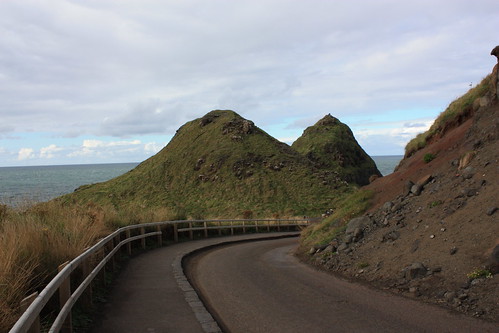
–
While I can’t definitively say whether or not that was true, the wind was quite intense. I could barely hear my audio guide. Everyone around seemed to be having the same problem. We all looked like we were the quiet end of a one-sided and very confusing cell phone conversation.
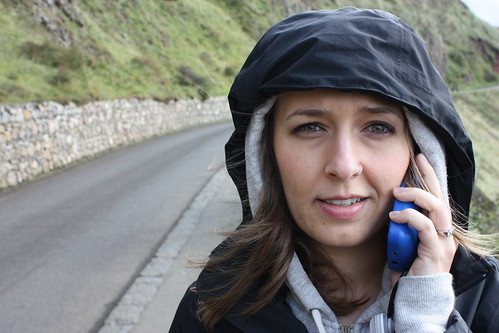
Wait, what?
–
And then we rounded a corner …
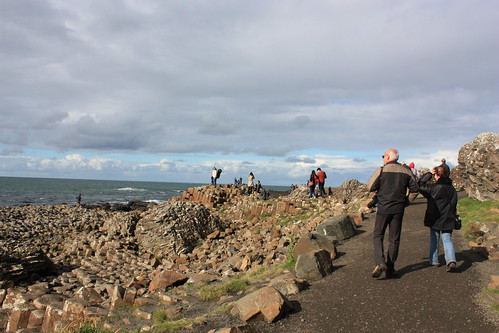
–
And there it was.

–

–
I can say, without hyperbole, that it was the most impressive hexagonal columnal basalt structure I had ever seen. I mean, it literally made every other hexagonal columnal basalt structure I’ve encountered look like a pile of crap, you know?
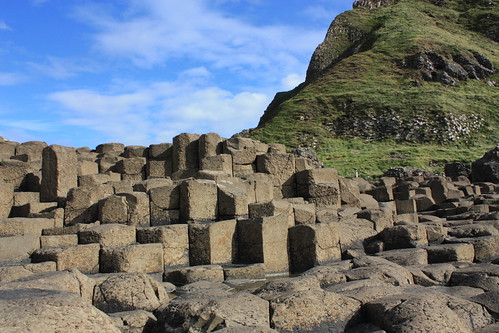
–
Rather remarkably, you can walk right on it. I guess the people from the National Trust reason that if something can withstand millions of years of erosion, as few hundred thousand tourists in tennis shoes aren’t going to make that much of a difference.
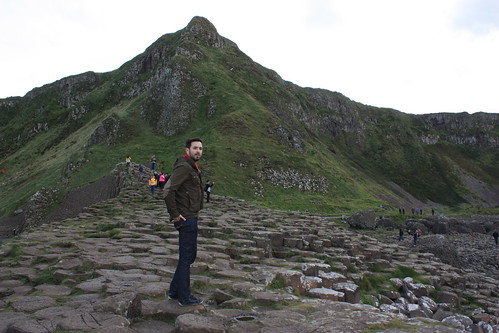
–
 –
–
Some folks even appeared to be having a picnic. Which is a nice idea in theory, but, if you’ll notice the sky in these photos, the weather was literally changing by the minute. Sun, then clouds, then drizzle, back to sun again. I’m not one to risk getting my scone damp.
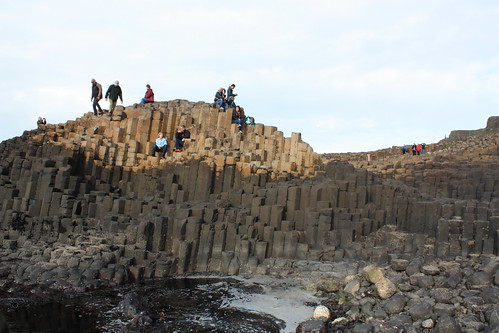
–
The lingering question, even after we’d read up on the place, listened to the audio guide, and stopped by the visitor’s center, remained: we kept wondering what exactly this place was. It felt more substantial than merely a geological formation. We wanted more of an explanation – the idea of lava flows and fast-cooling basalt sounded too simplistic.
Especially when you consider how wonderful and strange and complex life is.
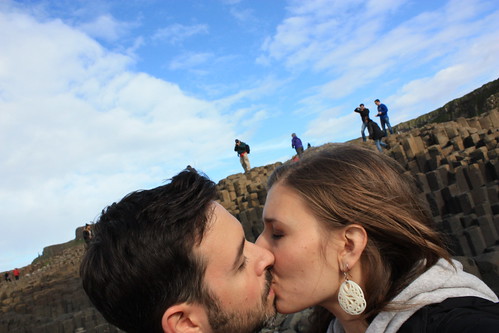
–
And so the idea that magic was at play, with giants and warriors and clever women wrapping their husbands up like infants, didn’t seem that far-fetched after all.
—————
The Essentials on The Giant’s Causeway:
- Verdict: Heck, yeah. The Causeway is on the list of UNESCO World Heritage Sites, and is considered one of the U.K.’s Seven Wonders.
– - How to get there: You can drive from Belfast (it will take you along what is arguably one of the most lovely roads in the world) and it shouldn’t take you more than 1.5 hours. HOWEVER, if you are not accustomed to driving on the opposite side of the road or operating a manual transmission, please note that serious martial strife may arise. There are also many, many tour buses that can take you here (lots of packages will also take you to the Bushmills Distillery, which we sadly arrived at after the tours had ended, as well as the Carrick-a-Rede rope bridge).
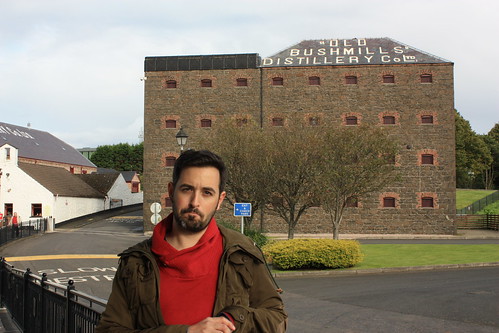
My dear husband, upon learning Bushmills was closed for the day.
–
- Ideal for: hikers, geology nerds (those exist, right?), and anyone who loves the outdoors.
– - Insider tips: wear comfy shoes and bring a windbreaker or a raincoat. The wind can get quite chilly, and the weather can switch from sunny and pleasant to lashing rain in a matter of seconds. There’s a shuttle that goes down to the Causeway every 10 minutes from the visitor’s center, but it will cost you 1 pound per person. Consider walking the half mile down, and then hopping on the shuttle for the ride back up. Also, you can make a day trip out of this and visit Carrick-a-Rede and Bushmills, too.
– - Nearby food: I’d recommend eating after you’ve seen the Causeway so, as one gentleman put it, “You won’t have to carry all that down with you.” The visitor’s center has a cafeteria with lunchtime staples: tea and an assortment of cakes, grilled sandwiches (flavors while we were there included tuna melt, cheddar and chutney, and ham and cheese), as well as soups and stews. I ordered the latter and found an entire potato in mine (it was still pretty good, though). The later in the day, the less of an assortment you’ll find.
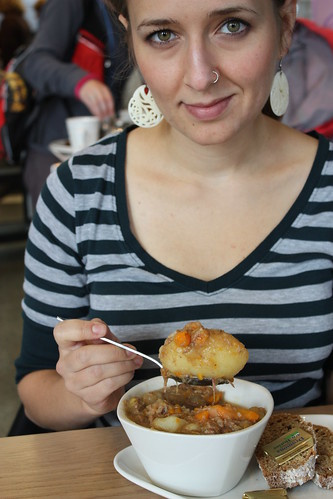 –
– - Good for kids: Yup. Exercise caution, as the terrain can be quite rough and some columns are rather tall and drop off sharply. Little ones who venture on their own might face a dangerous tumble. But they can scramble around and touch everything, which is a nice change from many tourist destinations. Plus, tidepools!



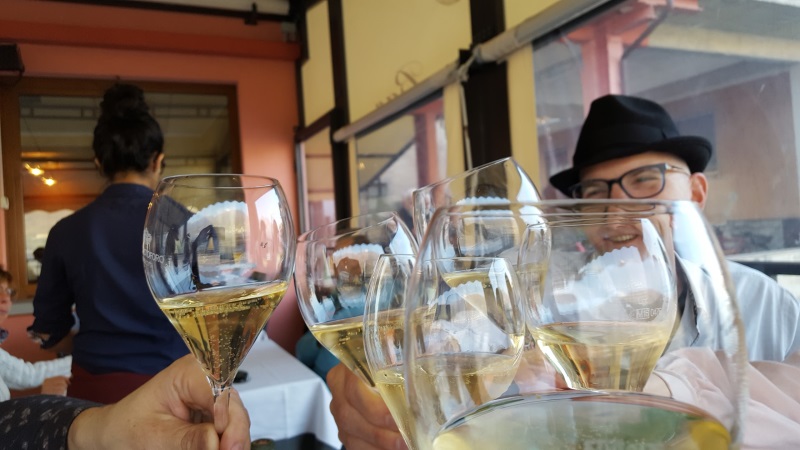
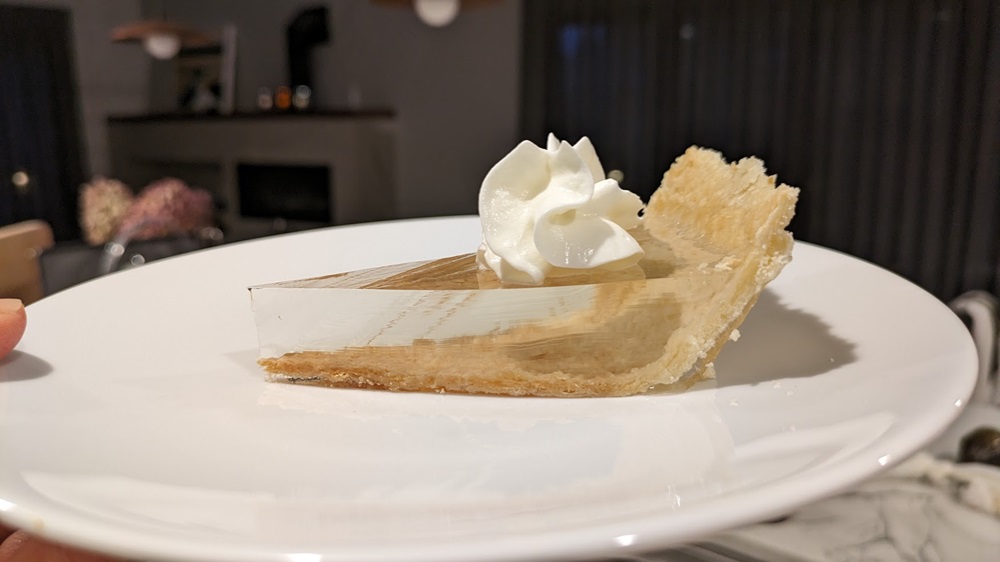





Leave a Comment